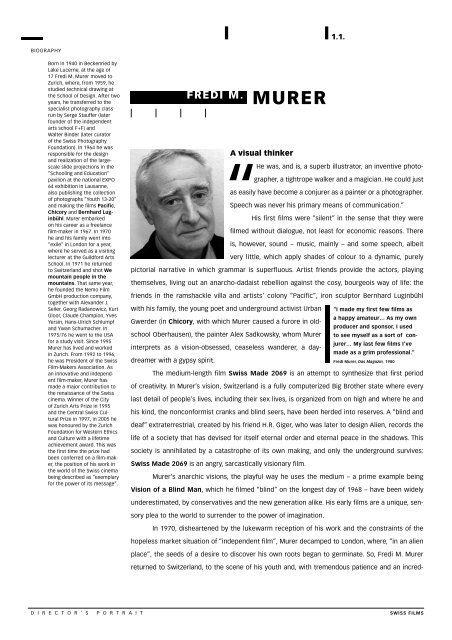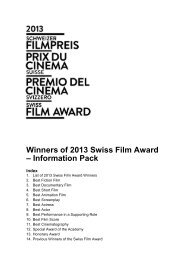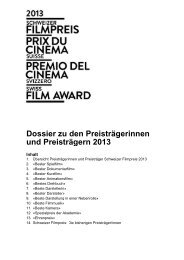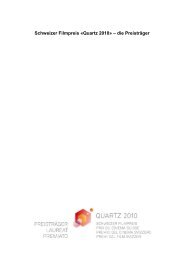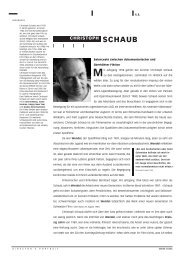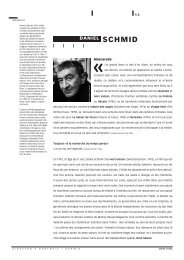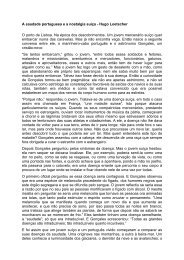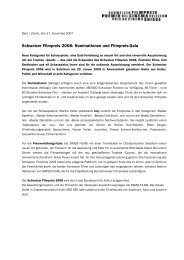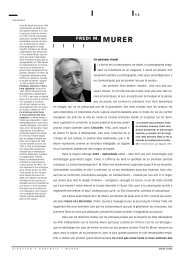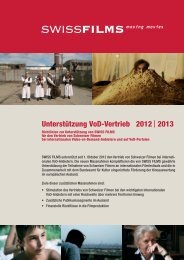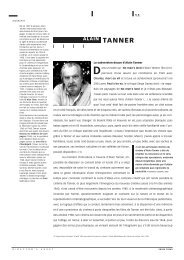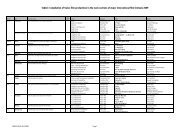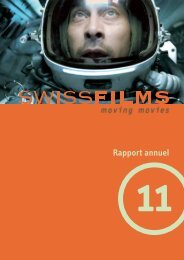Director's Portrait Fredi M. Murer - Swiss Films
Director's Portrait Fredi M. Murer - Swiss Films
Director's Portrait Fredi M. Murer - Swiss Films
You also want an ePaper? Increase the reach of your titles
YUMPU automatically turns print PDFs into web optimized ePapers that Google loves.
BIOGRAPHY<br />
Born in 1940 in Beckenried by<br />
Lake Lucerne, at the age of<br />
17 <strong>Fredi</strong> M. <strong>Murer</strong> moved to<br />
Zurich, where, from 1959, he<br />
studied technical drawing at<br />
the School of Design. After two<br />
years, he transferred to the<br />
specialist photography class<br />
run by Serge Stauffer (later<br />
founder of the independent<br />
arts school F+F) and<br />
Walter Binder (later curator<br />
of the <strong>Swiss</strong> Photography<br />
Foundation). In 1964 he was<br />
responsible for the design<br />
and realization of the largescale<br />
slide projections in the<br />
“Schooling and Education”<br />
pavilion at the national EXPO<br />
64 exhibition in Lausanne,<br />
also publishing the collection<br />
of photographs “Youth 13-20”<br />
and making the films Pacific,<br />
Chicory and Bernhard Luginbühl.<br />
<strong>Murer</strong> embarked<br />
on his career as a freelance<br />
film-maker in 1967. In 1970<br />
he and his family went into<br />
“exile” in London for a year,<br />
where he served as a visiting<br />
lecturer at the Guildford Arts<br />
School. In 1971 he returned<br />
to Switzerland and shot We<br />
mountain people in the<br />
mountains. That same year,<br />
he founded the Nemo Film<br />
GmbH production company,<br />
together with Alexander J.<br />
Seiler, Georg Radanowicz, Kurt<br />
Gloor, Claude Champion, Yves<br />
Yersin, Hans-Ulrich Schlumpf<br />
and Ywan Schumacher. In<br />
1975/76 he went to the USA<br />
for a study visit. Since 1995<br />
<strong>Murer</strong> has lived and worked<br />
in Zurich. From 1992 to 1996,<br />
he was President of the <strong>Swiss</strong><br />
Film-Makers Association. As<br />
an innovative and independent<br />
film-maker, <strong>Murer</strong> has<br />
made a major contribution to<br />
the renaissance of the <strong>Swiss</strong><br />
cinema. Winner of the City<br />
of Zurich Arts Prize in 1995<br />
and the Central <strong>Swiss</strong> Cultural<br />
Prize in 1997, in 2005 he<br />
was honoured by the Zurich<br />
Foundation for Western Ethics<br />
and Culture with a lifetime<br />
achievement award. This was<br />
the first time the prize had<br />
been conferred on a film-maker,<br />
the position of his work in<br />
the world of the <strong>Swiss</strong> cinema<br />
being described as “exemplary<br />
for the power of its message”.<br />
D I R E C T O R ’ S P O R T R A I T<br />
A visual thinker<br />
“<br />
He was, and is, a superb illustrator, an inventive photographer,<br />
a tightrope walker and a magician. He could just<br />
as easily have become a conjurer as a painter or a photographer.<br />
Speech was never his primary means of communication.”<br />
His first films were “silent” in the sense that they were<br />
filmed without dialogue, not least for economic reasons. There<br />
is, however, sound – music, mainly – and some speech, albeit<br />
very little, which apply shades of colour to a dynamic, purely<br />
pictorial narrative in which grammar is superfluous. Artist friends provide the actors, playing<br />
themselves, living out an anarcho-dadaist rebellion against the cosy, bourgeois way of life: the<br />
friends in the ramshackle villa and artists’ colony “Pacific”, iron sculptor Bernhard Luginbühl<br />
with his family, the young poet and underground activist Urban<br />
Gwerder (in Chicory, with which <strong>Murer</strong> caused a furore in old-<br />
school Oberhausen), the painter Alex Sadkowsky, whom <strong>Murer</strong><br />
interprets as a vision-obsessed, ceaseless wanderer, a day-<br />
dreamer with a gypsy spirit.<br />
FREDI M. MURER<br />
The medium-length film <strong>Swiss</strong> Made 2069 is an attempt to synthesize that first period<br />
of creativity. In <strong>Murer</strong>’s vision, Switzerland is a fully computerized Big Brother state where every<br />
last detail of people’s lives, including their sex lives, is organized from on high and where he and<br />
his kind, the nonconformist cranks and blind seers, have been herded into reserves. A “blind and<br />
deaf” extraterrestrial, created by his friend H.R. Giger, who was later to design Alien, records the<br />
life of a society that has devised for itself eternal order and eternal peace in the shadows. This<br />
society is annihilated by a catastrophe of its own making, and only the underground survives:<br />
<strong>Swiss</strong> Made 2069 is an angry, sarcastically visionary film.<br />
<strong>Murer</strong>’s anarchic visions, the playful way he uses the medium – a prime example being<br />
Vision of a Blind Man, which he filmed “blind” on the longest day of 1968 – have been widely<br />
underestimated, by conservatives and the new generation alike. His early films are a unique, sen-<br />
sory plea to the world to surrender to the power of imagination.<br />
In 1970, disheartened by the lukewarm reception of his work and the constraints of the<br />
hopeless market situation of “independent film”, <strong>Murer</strong> decamped to London, where, “in an alien<br />
place”, the seeds of a desire to discover his own roots began to germinate. So, <strong>Fredi</strong> M. <strong>Murer</strong><br />
returned to Switzerland, to the scene of his youth and, with tremendous patience and an incred-<br />
1.1.<br />
“I made my first few films as<br />
a happy amateur… As my own<br />
producer and sponsor, I used<br />
to see myself as a sort of conjurer…<br />
My last few films I’ve<br />
made as a grim professional.”<br />
<strong>Fredi</strong> <strong>Murer</strong>, Das Magazin, 1980<br />
SWISS FILMS
FILMOGRAPHY<br />
1962 Marcel<br />
1965 Pazifik – oder die Zufriedenen<br />
1965 Balance<br />
1965 Sylvan<br />
1966 Chicorée: Elf schizofragmentarische<br />
Aufzeichnungen<br />
über das Leben des Comte<br />
Ivan Merdreff<br />
1966 Bernhard Luginbühl<br />
1967 High and Heimkiller<br />
1969 Vision of a Blind Man<br />
1969 2069 – oder dort, wo sich<br />
Futurologen und Archäologen<br />
gute Nacht sagen<br />
1969 Sad-is-fiction<br />
1972 Passagen<br />
1973 Christopher & Alexander<br />
1974 Wir Bergler in den Bergen<br />
sind eigentlich nicht schuld,<br />
dass wir da sind<br />
1979 Grauzone<br />
1985 Höhenfeuer<br />
1987 Sehen mit anderen Augen<br />
1990 Der grüne Berg<br />
1998 Vollmond<br />
2004 Downtown Switzerland<br />
(Co-Director)<br />
2006 Vitus<br />
D I R E C T O R ’ S P O R T R A I T<br />
> A visual thinker<br />
FREDI M.<br />
ible amount of empathy, produced his first major documentary film, We mountain people in the<br />
mountains aren’t actually to blame for being here. But is this really a documentary? In terms<br />
of the absolute authenticity of the chronicling, the answer is yes; but in terms of the image and<br />
sound structure, the way it is edited into cyclical units, and the prosody of its individual parts,<br />
<strong>Murer</strong> has taken his cue from the direct, narrative style of modern European cinema.<br />
The basic premise is the magical “ring” that holds the world – the village, the family, the<br />
mountain region – together. At the centre of the film, the ring is evoked by the prayer song of<br />
a shepherd in front of a cabin and in the family circle, but the film itself essentially conjures it<br />
up throughout. Of course, the vulnerability of this “circle of peace” does not escape the film-<br />
maker, yet, without suppressing his sorrow, he still manages to recreate the “ring” in his own way,<br />
without nostalgia, from its surviving elements and through his cinematic gestures. The Green<br />
Mountain, one of <strong>Murer</strong>’s two major documentary films from<br />
the heart of Switzerland, can be seen as a more sombre echo<br />
of We mountain people in the mountains… The planned con-<br />
struction of a storage facility for radioactive waste brings the<br />
vulnerability of the “ring” into painful relief. This film depicts the<br />
complex issues at stake when the generation of go-getters and<br />
the civilization of the protectors and nurturers clash head-on. F. M. <strong>Murer</strong> dedicated this film,<br />
which is only saved from being an apocalyptic vision by the hope it places in the next generation,<br />
to the children and children’s children of the mountain farmers on the Wellenberg. Its central<br />
theme was to come to the fore again eight years later, in Full Moon.<br />
The three feature films in <strong>Murer</strong>’s filmography are, in terms of theme and iconography,<br />
almost inseparable from his documentary work and each other – in short, they are inextricably<br />
bound up with the job of film-making.<br />
MURER<br />
Zones expands on <strong>Swiss</strong> Made 2069 and also picks up the thread of the first film about<br />
mountain people. The main character, Alfred, whose job is to spy on others, becomes a sleuth<br />
and saves himself in the nick of time by finally listening to his own inner voice. The deaf boy in<br />
Höhenfeuer (Alpine Fire) (1985) lives in a world of touch and sight; only his sister, Belli, under-<br />
stands and loves his heightened sensitivity, and the two are forced to save each other, the life<br />
of their unborn child and their world. With incredible boldness of dramatic invention and a magi-<br />
cal clarity of vision and sensitivity, <strong>Murer</strong> champions the cause of nature, life and the future. In<br />
extremis, parricide and following our own infallible intuition become the only options. This is the<br />
point of departure of Full Moon, <strong>Fredi</strong> M. <strong>Murer</strong>’s latest film: twelve children disappear without<br />
1.2.<br />
People who’ve got something to<br />
tell usually have a stock of<br />
stories, regardless of what sets<br />
them going. <strong>Murer</strong>'s stories are<br />
picture stories characterized<br />
by quiet observation and stimulated<br />
by strong memories.<br />
Walter Ruggle, 1995<br />
SWISS FILMS
D I R E C T O R ’ S P O R T R A I T<br />
> A visual thinker<br />
a trace and confront their parents with an ultimatum: “We want the earth on earth – if you don’t,<br />
the earth will carry on revolving without us.” Full Moon is Zones, The Green Mountain, Alpine<br />
Fire and all our modern-day arrogance and fears rolled into one. As the modern-day audiovisual<br />
production line relentlessly gathers speed, <strong>Fredi</strong> M. <strong>Murer</strong>’s work progresses slowly by contrast,<br />
in what one might call “interim balances”.<br />
The fury and the fears are always the same; the settings vary, but the simple plea does not:<br />
“More make-believe, less violence.” This appeal would seem strange – not to say ridiculous – if<br />
it weren’t for <strong>Murer</strong>’s imagination as a film-maker, which keeps him from straying onto the well-<br />
trodden path of the typical, well-intentioned, “worthy” film. It<br />
is this cinematic invention that has earned him the status of a<br />
much admired (and, in some quarters, envied) standard-bearer<br />
for <strong>Swiss</strong> film, right from the days of his first films, when he overcame production constraints with<br />
such playfulness and when necessity was the mother of invention, and since he first turned his<br />
conjurer’s skill to the documentary film, with his authentic chronicling style, and to the feature<br />
film, with his complex interweaving of themes, symbols, sentences and gestures. Fiercely resisting<br />
the conventional “talkiness” of cinema at the start of his film career, <strong>Murer</strong> said that he could only<br />
speak in images and sounds. Not so, of course, as since then he has also explained his stance in<br />
his writings and seminars – and he pens his own screenplays. Even so, only the films, with their<br />
unique, unmistakable alchemy, reveal “the whole truth”.<br />
Martin Schaub, 1998<br />
FREDI M.<br />
MURER<br />
1.3.<br />
“I have to make films where<br />
they speak my language. <strong>Films</strong><br />
need a sense of home.”<br />
<strong>Fredi</strong> M. <strong>Murer</strong>, 2005<br />
SWISS FILMS
D I R E C T O R ’ S P O R T R A I T<br />
Seven questions to <strong>Fredi</strong> M. <strong>Murer</strong> by Irene Genhart<br />
1.4.<br />
INTERVIEW<br />
What does Switzerland mean to you? Switzerland is the country into which I was born – I had no<br />
say in the matter – and the country that, in terms of language, mentality and thinking, has shaped<br />
me to a degree I would never have thought possible. When I was asked, as a child, what I wanted to<br />
be when I grew up, apparently I always said: a foreigner. As a teenager, I refused to say “I’m <strong>Swiss</strong>”<br />
and would declare defiantly: “I am a person.” As an adult, I then realized, to my horror, that I had<br />
become <strong>Swiss</strong> first and a human being second. Despite this, I never stopped fighting against that<br />
overt “<strong>Swiss</strong>ness”, which in itself is a very <strong>Swiss</strong> attribute, or at least typical of my generation of<br />
’68. To me, Switzerland is, to quote the playwright Dürrenmatt, the “most open of prisons”, a place<br />
that, in my insatiable wanderlust, I have kept on leaving – I’ve visited almost every continent – only<br />
to return placated and with a greater sense of affection: I have shot every single one of my films in<br />
Switzerland.<br />
What do the children we encounter in your films, from MARCEL to FULL MOON, represent?<br />
If only I knew that myself. The main character in my new film is a twelve-year-old boy, too… Clearly,<br />
children make good “projection characters”. I certainly don’t see them as angels or saints: they<br />
make love to their sisters, do away with their parents or disappear without a trace… to my mind,<br />
children are the most credible representatives of intellectual honesty. The absoluteness and radic-<br />
alism of their thinking is still undiminished, perhaps because they don’t distinguish between reality<br />
and make-believe. I still believe that we reach our intellectual peak at the age of around twelve,<br />
and then, as we pass through school and the authorities get hold of us, we begin the process of<br />
conforming to social norms, sliding inexorably into safe normality.<br />
My childhood, which I spent in a large family in Nidwalden and Uri, provides me with an<br />
inexhaustible source of archetypal images and recollected feelings, which to this day are the life-<br />
blood of my artistic work: the “raw material” of all my films is provided by this early phase of my<br />
life. By choosing film as my medium, I have managed to smuggle a wonderful “sandpit” into my<br />
adulthood: on the screen, I can make my characters do and say things that I never would have got<br />
away with as a child.<br />
What do the three phrases: Artist – Art – Creativity/Artificiality mean to you? As a young<br />
boy, I was a talented gymnast, so I also felt like an artist. The way I saw it, there was an element of<br />
art involved in contorting your limbs into unnatural positions. But I was equally drawn to the show<br />
aspect. When I was older, I learned poems and Nietzsche texts by heart, and recited them at oppor-<br />
tune moments for dramatic effect. So, I felt like an artist at a very early age and thought that school<br />
SWISS FILMS
D I R E C T O R ’ S P O R T R A I T<br />
> Seven questions to <strong>Fredi</strong> M. <strong>Murer</strong><br />
was a complete waste of time. When I was a young film-maker living in Zurich, almost all my closest<br />
friends were poets, sculptors, musicians or painters, and they populated my early films as protago-<br />
nists. These rather experimental films were always a kind of “portrait of the artist”, although not<br />
in the conventional sense. Rather, they were creative duels between me behind the camera and<br />
them in front of the camera, and we were always very careful to keep the line between documen-<br />
tary and fiction fluid.<br />
Getting back to the original question, what has always fascinated me so much about the<br />
film medium is the blurred line between reality and invention, in other words the creative handling<br />
of art and artificiality: we sit in a cinema, staring at an artificially created image on the white screen<br />
and shedding real tears. Admittedly, that has a lot to do with the creativity and imagination of the<br />
viewer, too.<br />
Your films frequently contain utopian scenarios that hint at pessimistic apprehensions.<br />
What lies at the root of these fears? I believe that, since time immemorial, the desire to live,<br />
or to survive, has been inextricably bound up with fear. If that is the case, we must clearly have a<br />
certain desire for fear. How else can you explain why there are so many disaster films? At any rate,<br />
imagination and creativity know no bounds when it comes to portraying, evoking or even cultivat-<br />
ing these fears. I, for example, would rather be struck down by lightning than by a neighbour. Which<br />
leads me to conclude that I feel less threatened by forces of nature than I do by violence perpe-<br />
trated by people, particularly when that violence takes the guise of economic or social achieve-<br />
ment or technical progress.<br />
We all know that we can try to exorcise fear by giving it a face or by exposing its source or<br />
originator, and I have tried to do this in a number of my films. Zones anticipated the surveillance<br />
files scandal in Switzerland – which, by the way, exceeded even my darkest imaginings – ten years<br />
before it happened. The Green Mountain questions the ethical responsibility of nuclear tech-<br />
nology vis-à-vis future generations, Full Moon evokes our everyday apathy towards environmental<br />
issues and hands out a stark warning. But I would like to think that I have never succumbed to<br />
dogmatism or fanaticism in the cinematic portrayal of my personal fears, that I have used humour,<br />
irony, sarcasm and, perhaps, poetry instead.<br />
I have certainly always sided with minorities and championed the cause of nature. Actu-<br />
ally, I have my own pet theory about what “nature” is. The way I see it, there is a “first nature” and<br />
a “second nature”. “First nature” is the environment that has evolved organically from the dim<br />
and distant past, in other words before humans began leaving their mark. At which point “second<br />
1.5.<br />
INTERVIEW<br />
SWISS FILMS
D I R E C T O R ’ S P O R T R A I T<br />
> Seven questions to <strong>Fredi</strong> M. <strong>Murer</strong><br />
nature” would be the environment influenced, changed or even newly created by the hand of<br />
man. This includes everything from the bright green, fertilized fields, the felled rain forests and the<br />
animals born of selective breeding, to the avenues of poplars lining straightened rivers and the<br />
skyscrapers of Manhattan. When I stand on top of the Eiffel Tower, for instance, I am surrounded as<br />
far as the eye can see by “second nature”. And although, as a film-maker, what I produce is always<br />
“second nature”, I hope that my childlike wish – that I might be able to see the area that is modern<br />
Switzerland as it was before man appeared in the Holocene period – will be fulfilled, if only in a<br />
dream. The paradox is that, in fighting against the disappearance of “first nature”, we are inevitably<br />
fighting against ourselves.<br />
Your films often portray gifted people with disabilities, or to put it another way: charac-<br />
ters with one “handicapped sense”... Although the medium of film indisputably appeals to our<br />
visual and aural senses, and the interplay between image and sound creates marvellous fusions, as<br />
a film-maker I have always been particularly fascinated by the secret of the symbiotic relationship<br />
between image and sound. In my experimental film Vision of a Blind Man, I covered my eyes and<br />
filmed “blind” for a whole day, with the camera on my shoulder. At the same time, I talked into the<br />
microphone, recounting what I was hearing, touching or feeling, or what I saw in my imagination.<br />
For an audience watching the film, the discrepancy between the actual image and what I was<br />
seeing in my mind’s eye couldn’t be more stark. Vision of a Blind Man was also a kind of “pure<br />
research” for me. The recurring themes of blindness, deafness and muteness in some of my films<br />
– the deaf boy in Alpine Fire, or the portrayal of blind people in the documentary Seeing through<br />
other eyes – reflect the fact that, to me, the act of film-making is always a reflection on seeing<br />
and hearing too.<br />
Children know you for your 1001 little magic tricks. Why didn’t you become a magician?<br />
What is reality? I am a magician! Film-making has a lot in common with magic, both literally and<br />
metaphorically: you’re constantly trying to outsmart what passes for reality. Film-makers use a box<br />
of magic tricks. We work with illusion, fakery, sensory deception: the artificial becomes realistic<br />
and the realistic is revealed as artificial… Cooking, film-making and conjuring are, to me, closely<br />
related. There’s also the show effect, and a showman is nothing without a public to perform to:<br />
a magician without an audience to enchant is just as tragic a figure as a chef with no guests or a<br />
film-maker without an audience.<br />
1.6.<br />
INTERVIEW<br />
SWISS FILMS
ABOUT THE AUTHORS<br />
Martin Schaub (1937 – 2003)<br />
was one of the leading <strong>Swiss</strong><br />
writers on films. He contributed<br />
to <strong>Swiss</strong> and foreign newspapers,<br />
magazines and books.<br />
From 1968 he was an editor at<br />
the Tages-Anzeiger, a leading<br />
<strong>Swiss</strong> daily. Schaub was also<br />
co-founder and, for ten years,<br />
publisher of the <strong>Swiss</strong> film<br />
magazine CINEMA. Besides<br />
writing, he also worked on films<br />
of his own, including Die Insel<br />
with John Berger.<br />
Irene Genhart studied film,<br />
German language and literature,<br />
and philosophy at the<br />
universities of Zurich and<br />
Berlin. She writes for <strong>Swiss</strong><br />
newspapers, film magazines,<br />
catalogues and encyclopedias<br />
as a freelance journalist. She is<br />
a board member of the <strong>Swiss</strong><br />
film journalists' association and<br />
has been co-organizer of Critics’<br />
Week at the International<br />
Film Festival of Locarno.<br />
D I R E C T O R ’ S P O R T R A I T<br />
> Seven questions to <strong>Fredi</strong> M. <strong>Murer</strong><br />
When people discuss your films, they often talk about their “voicelessness”. Why do you<br />
think they are viewed in this way? Actually, that’s news to me. I don’t feel voiceless, in any<br />
event. I love to write and talk. My early films were silent in the literal sense, but that was more for<br />
technical and financial reasons. Admittedly, back then as a photography student making films, I<br />
tended to think more in pictures than in spoken sentences. But even during my silent film phase, I<br />
began putting creative soundtracks to my films. Later, as soon as I could afford to hire a “geplimte”<br />
16mm camera, I added speech. The fact that the performers in my documentary films or fictitious<br />
characters in my feature films are often mute, or taciturn, is an entirely separate issue. In We<br />
mountain people in the mountains… I managed to persuade the mountain people, who are gen-<br />
erally said to be unforthcoming, to open up in front of the camera. And as Alfred the professional<br />
spy says in Zones: “My father was taciturn, but he wasn’t mute.” There is a difference.<br />
Interview and transcription: Irene Genhart, Zurich 2004<br />
1.7.<br />
INTERVIEW<br />
SWISS FILMS
Script: <strong>Fredi</strong> M. <strong>Murer</strong><br />
Camera: <strong>Fredi</strong> M. <strong>Murer</strong><br />
Editing: <strong>Fredi</strong> M. <strong>Murer</strong><br />
“An untamed, strong will is at work<br />
here, a will that is able to shake off<br />
all fetters and, in places, the constraints<br />
of form, achieving a liberation<br />
that pushes back the creative<br />
boundaries of a film of universal<br />
relevance. Effective close-ups, striking<br />
overexposures, sharp cross-cuts,<br />
clever angles and a dynamic handling<br />
of the camera, which seems to<br />
revel in the joy of filming instead of<br />
just taking photographs, create tension<br />
and force.”<br />
Basler Nachrichten<br />
“That <strong>Murer</strong> is able to extract so<br />
much grotesqueness and jovial<br />
absurdity from reality with only<br />
the leanest resources, while at the<br />
same time meting out the odd<br />
jolt to the senses, is testament to<br />
the great talent of this still young<br />
illu-strator and director…”<br />
Berner Tagblatt (R. Welten)<br />
PACIFIC – OR THE CONTENTED<br />
1965 16mm b/w and hand-coloured 60’<br />
Pazifik – oder die Zufriedenen<br />
T<br />
F I C T I O N F I L M / M U R E R<br />
Cast: Sylvan Guntern, Jean-Marc Seiler,<br />
Erich Frei, Mario Berretta, Augustin<br />
Erb, Daniel Bamert, <strong>Fredi</strong> M. <strong>Murer</strong><br />
he setting: the condemned Villa Pazifik on the Zürichberg. Its occupants: seven men aged<br />
around twenty, one of whom is the film-maker. At the centre of Pacific – or the Contented<br />
is a table in the garden at which the friends eat and drink, and it is these sessions that provide the<br />
backdrop for the film’s portrayal of the phantasmagoria and dreams of the gathered company. One<br />
is trying his hand at tightrope walking, another is digging up a balloon at the cemetery. A third is<br />
playing piano, while a pair of ladies’ and men’s shoes dance together. Pacific – or the Contented,<br />
made in 1965, is a cinematic depiction of anarchic nonconformism. Shot on silent 16mm, with chop-<br />
py camerawork, the film combines slapstick interludes with “live” and animated sequences. Every<br />
so often, <strong>Murer</strong> has coloured in a detail by hand, while elsewhere he has edited the negative itself.<br />
Originally almost four hours long and shown with a live soundtrack, the version of Pacific – or the<br />
Contented that exists today has been cut by <strong>Fredi</strong> M. <strong>Murer</strong> to 60 minutes and has a soundtrack as<br />
experimentally playful as its images.<br />
Production: <strong>Fredi</strong> M. <strong>Murer</strong><br />
World Rights: <strong>Fredi</strong> M. <strong>Murer</strong><br />
Original Version: IT<br />
Award: Quality Prize of the <strong>Swiss</strong><br />
Federal Department of Home Affairs<br />
SWISS FILMS
Script: <strong>Fredi</strong> M. <strong>Murer</strong><br />
Camera: <strong>Fredi</strong> M. Mure<br />
“But it’s not about gags. It’s not<br />
about how the blind film-maker gets<br />
it all wrong. It’s about the attempt<br />
to conceive a film without using<br />
one’s eyes, and to illustrate it with<br />
sound. If anything, it is sound that is<br />
illustrated in this film…<br />
It is not the audience that is most<br />
strongly affected by experiments<br />
like Vision of a Blind Man, but the<br />
film-maker’s art.” Martin Schaub, 1969<br />
1969 16mm colour 45’<br />
V<br />
F I C T I O N F I L M / M U R E R<br />
Assistants: Renzo Schraner,<br />
Christian Kurz<br />
ision of a Blind Man, explained <strong>Fredi</strong> M. <strong>Murer</strong> at the premiere of what is by far his most<br />
experimental film, was “a cinematic form of pure research”: on 21 June 1968, at half-past-five<br />
in the morning, <strong>Murer</strong> pulls a pair of non-transparent welder’s goggles over his eyes and hoists a<br />
16mm Ariflex onto his right shoulder. During the course of the day, he is driven by two friends to<br />
twenty-one unfamiliar locations, where he films “by ear” and records the thoughts running through<br />
his head. Within <strong>Murer</strong>’s workography, Vision of a Blind Man marks the departure from surreal-<br />
ism and prefigures much that is still to come: the extraterrestrial with its built-in camera and tape<br />
recorder, who romps through <strong>Swiss</strong> Made 2069; the bugging specialist in Zones, the blind piano<br />
tuner in Full Moon – but also the blind people and their dogs whom we meet in <strong>Murer</strong>’s 1987 com-<br />
missioned film Seeing through other eyes.<br />
Production: <strong>Fredi</strong> M. <strong>Murer</strong><br />
World Rights: <strong>Fredi</strong> M. <strong>Murer</strong><br />
Original Version: IT<br />
VISION OF A BLIND MAN<br />
SWISS FILMS
Script: <strong>Fredi</strong> M. <strong>Murer</strong><br />
Camera: Hans Liechti<br />
Sound: Florian Eidenbenz<br />
“<strong>Fredi</strong> <strong>Murer</strong>’s images are stunning,<br />
in both the literary and the cinematic<br />
sense. The overall vision of<br />
the trapped human being and individuality<br />
stifled by conventions is<br />
interspersed with a series of standalone<br />
shots: Venetian blinds, partitions,<br />
walls, architectural features<br />
that restrict and confine, fences,<br />
doors, borders of all kinds, railings,<br />
balustrades. Confinement isn’t proclaimed,<br />
it’s demonstrated. <strong>Murer</strong><br />
says he was most acutely aware of<br />
this confinement after his experience<br />
in America, ‘where you can sit<br />
in a train for seven hours and, now<br />
and then, see a small house with<br />
two gaunt cows nearby, then nothing<br />
else for miles.’”<br />
Cinema 1/79 (Werner Jehle)<br />
“... I saved the best film at Locarno<br />
till last, as a delicious treat: Zones,<br />
by German-<strong>Swiss</strong> film-maker <strong>Fredi</strong><br />
M. <strong>Murer</strong>. From the reports I have<br />
heard, he is the ‘father’ of new<br />
<strong>Swiss</strong> film; after just one viewing<br />
of Zones (the soundtrack alone<br />
is a minor masterpiece) I would<br />
concur with this assessment. He is<br />
probably Switzerland’s foremost<br />
film-maker, alongside Godard, who,<br />
to quote <strong>Murer</strong>, ‘is neither a French<br />
film-maker nor a <strong>Swiss</strong> film-maker,<br />
but ‘Mister Cinema’…’”<br />
Cahiers du Cinéma, 304, 1979 (L. Skorecki,<br />
“Drei Postkarten aus Locarno”)<br />
1979 16mm b/w 99’ Grauzone<br />
Z<br />
F I C T I O N F I L M / M U R E R<br />
Editing: Rainer Trinkler<br />
Music: Mario Beretta, Beo Oertli<br />
Cast: Giovanni Früh, Olga Piazza, Peter<br />
ones is <strong>Fredi</strong> M. <strong>Murer</strong>’s first full-length fiction film, which <strong>Murer</strong> himself has described as a<br />
“fictitious documentary”. All of the action takes place over a long weekend. It is the “drama<br />
of passing time”, as <strong>Murer</strong> calls it, that determines the editing. On Friday evening, upon leaving his<br />
place of work. Alfred M., a bugging specialist for a large combine, witnesses a suspected abduc-<br />
tion. On his way home, he learns from the radio of an anonymous announcement that a mystery<br />
epidemic has been sweeping the country. At home, Alfred omits to tell Julia about the abduction,<br />
just as he has hidden his secret life from her. The anonymous announcement plunges the entire<br />
country into crisis. To prevent mass hysteria, the Federal Council imposes a reporting ban, but a<br />
few pirate stations continue to broadcast information and most people spend an uneasy Saturday<br />
evening at home. Over the next two days, Alfred meets a number of characters who are defending<br />
themselves against the “epidemic”. Finally, in a dreamlike, visionary moment, Alfred discovers that<br />
he was infected by the “epidemic” long ago. With its densely atmospheric black-and-white images<br />
and clever multi-layered soundtrack, Zones is a fairly accurate reflection of the depressive climate<br />
of conformism that shaped Switzerland shortly before the youth uprisings of the 1980s. As a part of<br />
<strong>Murer</strong>’s oeuvre, Zones sits somewhere between <strong>Swiss</strong> Made 2069 and Full Moon, and in terms of<br />
its realism it can be seen as anticipating the surveillance files scandal that sent shockwaves rever-<br />
berating across Switzerland a decade later.<br />
Siegentaler, Walo Lüönd, Janet Haufler,<br />
Mathias Gnädiger, Michael Massen,<br />
Ernst Stiefel<br />
Production: Bernhard Lang AG<br />
World Rights: <strong>Fredi</strong> M. <strong>Murer</strong><br />
Original Version: <strong>Swiss</strong> German/<br />
German<br />
ZONES<br />
SWISS FILMS
Script: <strong>Fredi</strong> M. <strong>Murer</strong><br />
Camera: Pio Corradi<br />
Sound: Florian Eidenbenz<br />
“In Alpine Fire, <strong>Fredi</strong> M. <strong>Murer</strong><br />
presents a film that is more than<br />
just a repetition or a reworking of<br />
his earlier attempts, more than just<br />
an advance on those earlier works;<br />
it is in fact the sum of everything<br />
that the film-maker, in more than<br />
twenty years of resolute, uncompromising<br />
work, has achieved:<br />
a complete film. This film by the<br />
45-year-old poet of the New <strong>Swiss</strong><br />
Cinema is, without doubt, the most<br />
sumptuous and vibrant <strong>Swiss</strong> film<br />
of the year. Along with Tanner’s<br />
Jonas, Yersin’s Les petites fugues<br />
and Imhoof’s The Boat Is Full, it will<br />
go down as one of the most important<br />
post-war films to come out of<br />
Switzerland.”<br />
Cinema 31, 1985<br />
1985 35mm colour 117’ Höhenfeuer<br />
T<br />
F I C T I O N F I L M / M U R E R<br />
Editing: Helena Gerber<br />
Music: Mario Beretta<br />
Cast: Rolf Illig, Dorothea Moritz,<br />
he first sketch of Alpine Fire was conceived – as one episode in a multi-episode film on the<br />
subject of sexuality that was never made – in 1979, six years before it was shot. But after<br />
Zones he seriously doubted his ability to direct actors, so he took some time out from his creative<br />
endeavours, earned a living as an editor and attended a drama course with Lee Strasberg. A six-<br />
month stay in Iceland restored him to the right of frame of mind, and, on his return, <strong>Murer</strong> devel-<br />
oped the sketch into a fifteen-page narrative. At that time, he wanted to try his luck as a screenplay<br />
writer; he also intended for the film to be set in the isolation of Iceland. However, financing and<br />
production constraints brought the project back to Switzerland and, in the end, <strong>Murer</strong> himself also<br />
directed the film. The film is a tale of incest played out on a remote <strong>Swiss</strong> mountain farm located<br />
just below the tree line. This is where the boy, who was born deaf and remains nameless for the<br />
duration of the film, lives together with his elder sister, Belli, his father and his mother. The family<br />
keeps itself to itself. They have no eye contact with their nearest neighbours and the walk to Mass<br />
or to the market in the village in the valley means a whole day’s outing. The boy has been sent high<br />
up into the mountains by his father to clear the ground of rocks. When Belli visits her brother in his<br />
isolation, the two become lovers. Back on the farm, the siblings live alongside their parents, keep-<br />
ing their love a secret, until Belli’s pregnancy betrays her and a tragedy becomes inevitable. Alpine<br />
Fire was awarded the Golden Leopard at the 1985 Locarno Film Festival and is <strong>Fredi</strong> M. <strong>Murer</strong>’s<br />
most successful film to date. It is impressive for its ethnological accuracy, the silent beauty of the<br />
mountain landscape and above all – in common with all of <strong>Murer</strong>’s films – for its polished, dense,<br />
“natural” soundtrack.<br />
Johanna Lier, Thomas Nock,<br />
Jörg Odermatt, Tilli Breidenbach<br />
Production: Bernhard Lang AG<br />
World Rights: Bernhard Lang<br />
Original Version: <strong>Swiss</strong>-German<br />
ALPINE FIRE<br />
SWISS FILMS
Script: <strong>Fredi</strong> M. <strong>Murer</strong><br />
Camera: Pio Corradi, Patrick<br />
Lindenmaier<br />
Sound: Henri Maïkof<br />
“Full Moon is a complex, metaphorical<br />
film about the mood of our<br />
times and our society. The story,<br />
which is dramatic and ironic in<br />
equal measure, is a heartfelt plea<br />
for more imagination, for us to<br />
break free from the constraints of<br />
logic and our obsession with feasibility,<br />
and to hang on to that element<br />
of the unknown that allows us<br />
still to hope.”<br />
Zoom 3/98 (Martin Schlappner)<br />
“Twenty years down the line from<br />
his visionary portrait of an era,<br />
Zones, <strong>Murer</strong> has pulled off another<br />
great feat, not just of sincerity but<br />
also of ironic, everyday wisdom.<br />
His magical-realistic, candid feature<br />
film, which is full of odd twists, is<br />
both utopian and realistic, <strong>Swiss</strong><br />
and European, in the way in which<br />
it presents a world in which childlike<br />
imagination, understanding and<br />
trust have been lost. An amusing<br />
and resonant incitation to give our<br />
imaginations free rein, to reflect<br />
and to react.”<br />
Appenzeller Zeitung, 16 March 1998 (Rolf<br />
Breiner)<br />
1998 35mm colour 156’ Vollmond<br />
A<br />
F I C T I O N F I L M / M U R E R<br />
Editing: Loredana Cristelli<br />
Music: Mario Beretta<br />
Cast: Hanspeter Müller, Lilo Baur,<br />
Benedict Freitag, MarieBelle Kühn,<br />
Joseph Scheidegger, Verena Zimmermann,<br />
Soraya Gomaa, Max Rüdlinger,<br />
Sara Capretti<br />
Production: T&C Film Zürich<br />
World Rights: T&C Film Zürich<br />
Original Version: <strong>Swiss</strong>-German<br />
FULL MOON<br />
lmost thirteen years pass before, on 22 May 1998, <strong>Fredi</strong> M. <strong>Murer</strong> presents Full Moon, his<br />
second-longest feature film after Alpine Fire. The fictitious case on which the film is based<br />
did later happen in real life, to the horror of the <strong>Swiss</strong> population. On a full moon night in the spring<br />
of 1998, twelve ten-year-old children go missing in Switzerland. Detective Inspector Wasser, who<br />
investigated the disappearance of Toni Escher by Lake Greifen, discovers the true magnitude of the<br />
disaster while surfing the Net: Full Moon could not be further removed from the leisurely timeless-<br />
ness that made <strong>Murer</strong>’s Alpine Fire a pièce de résistance of Helvetic cinematography. Highly top-<br />
ical and contemporary, Full Moon – which takes society to task in the same way Zones did back<br />
in 1979 – takes a kaleidoscopic look at the prevailing mood of <strong>Swiss</strong> society. What kind of parents,<br />
asks <strong>Murer</strong>, do today’s children have, what are the circumstances of their formative years? The<br />
most important question, however – and this is where <strong>Murer</strong> the sceptic comes to the fore once<br />
more – is: Is the world in which our children live actually worth living in? Wasser, a detective as they<br />
are often imagined in books, takes on the baffling case with care and concern. In Full Moon, <strong>Murer</strong><br />
employs an unruly, jigsaw-like narrative approach, serving up a New Age-style potpourri, a chaotic<br />
mix of genres in which individual fates combine into a mass tragedy. “We want the earth on earth” is<br />
the children’s demand. <strong>Murer</strong> was prompted to make Full Moon by his daughter Sophia, who, after<br />
the Chernobyl nuclear disaster, asked her father to make a “film about how dangerous grown-ups<br />
are”. <strong>Murer</strong> also knows from personal experience that nothing is more alarming to a parent than a<br />
lost child: years ago, he lost sight of his other daughter, Sabina, in the middle of London for fifteen<br />
minutes. Today, <strong>Murer</strong> describes the experience as the worst fifteen minutes of his life.<br />
SWISS FILMS
Camera: Pio Corradi, Jann Erne,<br />
Kaspar Kasics, Pierre Mennel,<br />
Filip Zumbrunn<br />
"Angered by the political situation,<br />
four film directors each went out,<br />
armed with their cameras, to track<br />
down evidence, and then pooled<br />
their material to make a film. The<br />
result, Downtown Switzerland, is<br />
an impressive image of the city of<br />
Zurich in the winter of 2003/04.<br />
Blick, 20 Oct. 2004 (Rico Bandle)<br />
"Film-makers are a bit like climatologists.<br />
Whether consciously or<br />
not, they take the pulse of their<br />
surroundings and measurements of<br />
the social climate. <strong>Films</strong> on the local<br />
ethnological climate, with their<br />
‘journeys into the interior’ have a<br />
certain tradition in Switzerland.<br />
Zones is a case in point, a film by<br />
<strong>Fredi</strong> M. <strong>Murer</strong> some years ago that<br />
takes a disquieting look at the<br />
anonymity of Zurich. Now <strong>Murer</strong> is<br />
one of the four who, with pent-up<br />
anger, as they all admitted, set out<br />
in 2003 to investigate their surroundings.<br />
The grey zones have long<br />
since given way to bright colours,<br />
the city is basking in the trendy role<br />
of Downtown Switzerland. If only<br />
this label used by Zurich Tourism<br />
were somewhat less arrogant...<br />
But is it wrong? Like it or not, Zurich<br />
is the country's trendsetter – also<br />
in matters of harshness and increasing<br />
aggressiveness. On the other<br />
hand, this downtown may still, in<br />
its characteristics, be more closely<br />
related to the rest of the country<br />
than it is willing to acknowledge. Its<br />
attempts at cosmopolitan grandeur<br />
regularly fall flat. Zurich is contradiction<br />
live, which fits the concept of<br />
having four film-makers with very<br />
different approaches put forward<br />
and amalgamate their momentary<br />
views of the city.<br />
NZZ am Sonntag, 17 Oct. 2004 (Martin Walder)<br />
2004 35mm colour 94’<br />
I<br />
F I C T I O N F I L M / M U R E R<br />
Sound: Christian Davi, Jann Erne,<br />
Matteo Pellegrini, Lukas Piccolin<br />
Editing: Stefan Kälin<br />
Music: Thomas Korber, Galoppierende<br />
Zuversicht, Minimetal & Luxus<br />
Production: Fontana Film, eXtra-Film,<br />
FMM Film GmbH, Hugofilm GmbH<br />
DOWNTOWN SWITZERLAND<br />
n autumn 2004, <strong>Fredi</strong> M. <strong>Murer</strong>, in collaboration with Christian Davi, Stefan Haupt and Kaspar<br />
Kasics, presents Downtown Switzerland. This is not one of a series of films, but a stand-alone<br />
portrait of a city in which the <strong>Swiss</strong> metropolis is subjected to a reality check from varying perspec-<br />
tives. Some of the people who give their views in Downtown Switzerland use adjectives such as<br />
“urban”, “brilliant”, “gorgeous”, “cosmopolitan, dynamic, colourful”, “vital, fun and multicultural” to<br />
describe Zurich. Others, however, think that the city that was home to Zwingli is now a dirty and<br />
aggressive place, and they talk of how they are afraid to walk through Zurich’s streets at night.<br />
Conversations with Zurich’s residents, with people on the streets, with shop-owners, politicians,<br />
foreigners and natives, children and adults, tram drivers, captains of industry and sociologists paint<br />
a – political – mood that reflects the existential orientation of the people who live, work and play in<br />
Zurich. The interviews are complemented by journeys through and panning shots across the city.<br />
When asked what the “reality check” carried out in Downtown Switzerland means to him, <strong>Murer</strong><br />
says: “For me, it was about discovering my city and satisfying my curiosity. I live in District One,<br />
in the village. My Zurich is what, as a villager, I can reach by foot within ten minutes. To many of<br />
Zurich’s residents, my Zurich is a harmless idyll. They say that the real Zurich is elsewhere. So where<br />
is it? Driven by curiosity, I set about discovering, with my camera, the Zurich beyond my walking<br />
radius. As a villager, I have no idea what’s going on in District Nine or Eleven. That’s what motivated<br />
me, with my camera running and spurred on by curiosity, to make expeditions to the margins of<br />
Zurich – where I encountered the real Switzerland.”<br />
Original Version: <strong>Swiss</strong>-German/<br />
German/English/French<br />
World Rights: Frenetic <strong>Films</strong><br />
SWISS FILMS
Script: Peter Luisi, <strong>Fredi</strong> M. <strong>Murer</strong>,<br />
Lukas B. Suter<br />
Camera: Pio Corradi<br />
“If Alpine Fire was a classical tragedy<br />
that was also a film of earth<br />
and fire, and Full Moon was a Rousseau-like<br />
exercise in civilisational<br />
criticism with resonances of water,<br />
then Vitus is a film about air. Not<br />
only does the boy realize his grandfather’s<br />
dream of flying – in a work<br />
that deliberately leaves a great deal<br />
hanging, flight can assume many<br />
forms. It is encountered as a metaphor<br />
or myth extending even into<br />
the musical and economic realms.<br />
<strong>Murer</strong> carries on the threads of his<br />
earlier films. They, too, were always<br />
appeals for a type of perception<br />
that transcends the superficially visible<br />
and audible.”<br />
Reto Baumann, WOZ, 2 February 2006<br />
“Vitus tells a story of assimilation<br />
and resistance, and its director<br />
would not be called <strong>Fredi</strong> M. <strong>Murer</strong><br />
if the whole enterprise were not<br />
characterised by a gently subversive<br />
approach. With subtle irony, the film<br />
traces the birth of a piano virtuoso<br />
out of the spirit of guile. (...) The<br />
idea of the double life with which<br />
Vitus outwits the people around is<br />
intriguing. All the more as the director<br />
succeeds in doing practically the<br />
same thing with us, his viewers.”<br />
Nicole Hess, Tages-Anzeiger, 1 February 2006<br />
F I C T I O N F I L M<br />
Sound: Hugo Poletti<br />
Editing: Myriam Flury<br />
Music: Mario Beretta<br />
2004 35mm colour 100'<br />
V<br />
itus is the story of a childhood, or more precisely, the story of an almost unimaginably gifted<br />
boy called Vitus, alias Teo Gheorghiu, whose parents have laid challenging and ambitious plans<br />
for him: they want him to become a pianist.<br />
Cast: Teo Gheorghiu, Bruno Ganz,<br />
Julika Jenkins, Urs Jucker<br />
Production: Vitusfilm GmbH<br />
Twenty years after his internationally acclaimed masterpiece Alpine Fire, <strong>Fredi</strong> M. <strong>Murer</strong> once again<br />
places a very special boy at the centre of a film: Vitus possesses enormous musical and mathemati-<br />
cal gifts and career hopes to match. But he soon tires of the tedious role of being a young pianist<br />
and child prodigy and makes a dramatic escape into a double life.<br />
Vitus is a universal story, a declaration of love to childhood and music, told with humour and poetic<br />
grace. With its thematic focus on a multi-talented (young) person who defies social conventions and<br />
its cinematographic interest in the world of the senses, it is a “typical <strong>Murer</strong> film”.<br />
World Rights: Vitusfilm GmbH<br />
Original Version: <strong>Swiss</strong>-German/<br />
English<br />
VITUS<br />
“All grown-ups were once children – although few of them remember it,” writes Antoine de Saint-<br />
Exupéry in his introduction to The Little Prince. <strong>Murer</strong> pursues a similar idea: “The question is how<br />
the potential of every child can be kept alive into adulthood.” Vitus is one answer to that question.<br />
SWISS FILMS
Script: <strong>Fredi</strong> M. <strong>Murer</strong><br />
Camera: <strong>Fredi</strong> <strong>Murer</strong>, Fritz E. Maeder<br />
Editing: Renzo Schraner,<br />
SAD-IS- FICTION<br />
1969 16mm colour 43’ A metaphysical portrait of the painter Alex Sadkowsky<br />
S<br />
D O C U M E N T A R Y / M U R E R<br />
<strong>Fredi</strong> M. <strong>Murer</strong><br />
Music: The Minstrels, The Coincidence<br />
Actor and text: Alex Sadkowsky<br />
Voice: Alex Sadkowsky<br />
Production: <strong>Fredi</strong> M. <strong>Murer</strong><br />
ad-is-fiction, <strong>Fredi</strong> M. <strong>Murer</strong>’s third artist film, takes as its subject the Zurich-based painter<br />
and poet Alex Sadkowsky. “Modern man leans neither to the right nor to the left; he just keeps<br />
walking” runs the start of the programmatic introduction – and, for the rest of the film, Sadkowsky<br />
does just that. He wanders through aeroplanes and through London, and leaps across rocky land-<br />
scapes. Whenever he feels lonely, he carries with him an “animal metaphysicum”, which originated<br />
in his paintings. Sad-is-fiction portrays Sadkowsky as a visionary dreamer who – although he is in<br />
fact a father, artist, lover and, above all, a man with, to put it mildly, a gift of the gab – resists being<br />
pigeonholed in any way. In Sad-is-fiction, <strong>Murer</strong> works for the first time with direct sound and, for<br />
the first time, employs a colleague in the shape of cameraman Fritz E. Maeder.<br />
World Rights: <strong>Fredi</strong> M. <strong>Murer</strong><br />
Original Version: German<br />
SWISS FILMS
Script: <strong>Fredi</strong> M. <strong>Murer</strong><br />
Camera: <strong>Fredi</strong> M. <strong>Murer</strong><br />
“In Passages, <strong>Murer</strong> makes… a bold<br />
attempt to comprehend an idiosyncratic<br />
artist from the perspective of<br />
his own life experiences and fixed<br />
ideas.”<br />
Luzerner Neueste Nachrichten, 7 Feb.1973<br />
1972 16mm colour 50’ Passagen<br />
P<br />
D O C U M E N T A R Y / M U R E R<br />
Sound: Benny Lehmann<br />
Editing: Yves Yersin, <strong>Fredi</strong> M. <strong>Murer</strong><br />
assages, dating from 1972, is <strong>Fredi</strong> M. <strong>Murer</strong>’s fourth and, to date, last artist film. It was the<br />
first film that <strong>Murer</strong> shot with Nemo Film AG, the group of writers and producers that he co-<br />
founded, and – because a television company is involved – it differs markedly from his earlier artist<br />
portraits. Instead of filming the artist and his work in a wildly experimental vein, in Passages <strong>Murer</strong><br />
delivers an in-depth analysis of Giger’s work, supported by the opinions of various experts. The film<br />
focuses on the creative process, the correlations between Giger’s inner worlds and his pictures.<br />
“Does the artist have a role to play in society, or is he nothing more than a seismograph tracking<br />
the Zeitgeist?” is the question asked in Passages. Yet again, this points to the themes of <strong>Murer</strong>’s<br />
feature films such as Zones and Full Moon: the obligations to the world of the individual in general<br />
and of the artist in particular.<br />
Cast: H.R. Giger (artist/painter)<br />
Production: Nemo Film, WDR, Cologne<br />
World Rights: <strong>Fredi</strong> M. <strong>Murer</strong><br />
Original Version: German<br />
PASSAGES<br />
SWISS FILMS
Script: <strong>Fredi</strong> M. <strong>Murer</strong><br />
Camera: <strong>Fredi</strong> M. <strong>Murer</strong>,<br />
Iwan Schumacher<br />
“<strong>Murer</strong>, himself a father to two<br />
little girls, has reciprocated with<br />
appealing and sensitive portraits of<br />
children. In his film Christopher &<br />
Alexander… he deliberately chooses<br />
not to denounce the wealthy environment<br />
in which the two boys<br />
grow up; the film is not about class<br />
struggle. ‘I don’t want to have to<br />
make a statement in every film,’ he<br />
says. In a spirit of solidarity with the<br />
children, he made the film for them,<br />
so that ‘they can look back and see<br />
what they used to be like.’”<br />
Züri Leu, 15 Feb. 1974 (René Bortolani)<br />
1973 16mm colour 46’<br />
F<br />
D O C U M E N T A R Y / M U R E R<br />
Sound: Benny Lehmann<br />
Music: Jonas C. Haefeli<br />
redi M. <strong>Murer</strong> was right in the middle of preparing to film We mountain people in the moun-<br />
tains… when he got an offer from a Zurich private banker to make a cinematic portrait of his<br />
three- and five-year-old sons. <strong>Murer</strong> accepted the task, mainly because he relished the chance to<br />
look behind the hedge of a grand villa. What resulted was a film in two parts. The first part shows<br />
the course of an ordinary day in the life of the two boys. The second part deals with the main<br />
events on the family calendar, such as birthdays and holidays, which give definition to the year.<br />
For a while, Christopher & Alexander, which received mixed reviews, was carefully omitted from<br />
<strong>Murer</strong>’s workography. Today, <strong>Murer</strong> describes the dual portrait as one of his ethnographic films, and<br />
considers We mountain people in the mountains… and Christopher & Alexander to be com-<br />
plementary works.<br />
Production: Nemo Film AG Zurich,<br />
Artco-Film SA Geneva, Eric Franck<br />
World Rights: Artco-Film SA Geneva<br />
Original Version: French<br />
CHRISTOPHER & ALEXANDER<br />
SWISS FILMS
Script: <strong>Fredi</strong> M. <strong>Murer</strong>, Jean-Pierre<br />
Hoby, Georg Kohler<br />
Camera: Iwan P. Schumacher<br />
“This time, <strong>Murer</strong> has abandoned<br />
all the formal gimmicks and effects<br />
that often played such an important<br />
role in his earlier films, and instead<br />
has given the stage over to these<br />
mountain people, their existence<br />
and their troubles. <strong>Murer</strong>’s attitude<br />
is most apparent in the way he has<br />
made the film, and his personal<br />
stance is probably best reflected by<br />
the music he has used for individual<br />
sequences – György Ligeti for the<br />
tunnel images at the beginning,<br />
an unknown piece by Prokofiev<br />
when an avalanche disaster in the<br />
Schächental is mentioned, and so<br />
on… As a document of modern<br />
Switzerland, <strong>Murer</strong>’s film has great<br />
cultural and political value. Not<br />
least, it is a challenge to the credibility<br />
of our much-vaunted federal<br />
solidarity.”<br />
Zoom 15/74 (Franz Ulrich)<br />
WE MOUNTAIN PEOPLE IN THE MOUNTAINS …<br />
1974 16mm colour 108’ Wir Bergler in den Bergen sind eigentlich nicht schuld, dass wir da sind<br />
O<br />
D O C U M E N T A R Y / M U R E R<br />
Sound: Luc Yersin<br />
Editing: <strong>Fredi</strong> M. <strong>Murer</strong>, Eveline<br />
Brombacher<br />
riginally he wanted to set five legends from the Uri mountains in the present. But after more<br />
than six months’ local research, <strong>Murer</strong> was forced to admit that the old world of myth and<br />
legend had all but vanished from modern-day <strong>Swiss</strong> culture. In conversations with locals, the talk is<br />
of present-day problems caused by the industrialization of the mountain canton of Uri, such as the<br />
migration of young people to the cities. It also became clear to <strong>Murer</strong> that he didn’t want to make<br />
a film about the mountain dwellers, but that he wanted to give these people – who, in the modern<br />
world, are increasingly at risk of being denied a voice – the chance to speak. Thus We mountain<br />
people in the mountains… turned into an ethnographic documentary film in three movements,<br />
along the lines of a symphony. The three movements reflect the three differing stages of develop-<br />
ment co-existing within the mountainous canton. In Göschenen, at the foot of the Gotthard, which<br />
straddles Europe’s North-South axis, industrialization took hold long ago, and the mountain farmers<br />
of old now work in offices and factories. In the Schächtental, however, the traditional family-centric<br />
mountain economy survives. Meanwhile, the village of Bristen in the Maderanertal is in the throes<br />
of upheaval: while the traditional farming communities still exist, nigh on 250 inhabitants leave the<br />
area daily to go to work or school. With We mountain people in the mountains…, <strong>Murer</strong> finds<br />
himself for the first time outside his familiar territory of “cinéma copain”. The subject matter and<br />
formal characteristics are the same: like the artists and nonconformists of his earlier films, the<br />
mountain farmers live on the fringes of society; and, in terms of form, We mountain people in<br />
the mountains… , with its gentle camerawork, organic editing and clever soundtrack, has much in<br />
common with a long ballad or a poem.<br />
Production: Nemo Film AG, with the<br />
support of the <strong>Swiss</strong> Broadcasting<br />
Corporation, the <strong>Swiss</strong> Federal Department<br />
of Home Affairs, Migros, the Canton<br />
of Uri and further private funding<br />
World Rights: <strong>Fredi</strong> M. <strong>Murer</strong><br />
Original Version: <strong>Swiss</strong>-German<br />
SWISS FILMS
Script: <strong>Fredi</strong> M. <strong>Murer</strong><br />
Camera: Pio Corradi<br />
“As Bertrand Russell put it, the<br />
question right now is how to overcome<br />
‘the unwillingness of the<br />
human race to acquiesce to its own<br />
survival’. This same question reverberates<br />
through <strong>Fredi</strong> M. <strong>Murer</strong>’s<br />
film The Green Mountain. It is not,<br />
however, an attempt to persuade,<br />
but a cinematic ‘Landsgemeinde’,<br />
a form of grassroots democracy<br />
addressing big and small issues to<br />
do with the disposal of radioactive<br />
waste… On all levels, the democratic<br />
spirit is maintained. Despite<br />
the complexity of the subject,<br />
despite the differing positions and<br />
despite the ‘for and against’ split,<br />
<strong>Fredi</strong> M. <strong>Murer</strong> and his excellent<br />
team, headed by cameraman Pio<br />
Corradi, have succeeded in creating<br />
a cinematic whole which avoids<br />
arrogant interrogation, gives people<br />
time to reflect and presents the<br />
encounter to the audience in a way<br />
that invites us to form our own<br />
opinion. The Green Mountain is an<br />
outstanding work, which pursues<br />
its formal, artistic goals and its message<br />
with the same single-mindedness.<br />
This film, whose geographical<br />
and thematic focus is the Wellenberg,<br />
becomes a mirror of modernday<br />
Switzerland.”<br />
Der kleine Bund, 16 June 1990 (Fred Zaugg)<br />
“In the last few decades, there has<br />
been a sore lack of <strong>Swiss</strong> documentary<br />
films that have dealt convincingly<br />
with contemporary <strong>Swiss</strong><br />
reality. With The Green Mountain,<br />
<strong>Fredi</strong> M. <strong>Murer</strong> has not only tackled<br />
a highly topical theme, but picked<br />
away at the seams between what<br />
we are told and the real truth.”<br />
NZZ, 1 June 1990 (Christoph Egger)<br />
1990 16mm colour 128’ Der grüne Berg<br />
W<br />
D O C U M E N T A R Y / M U R E R<br />
Sound: Tobias Ineichen and Florian<br />
Eidenbenz<br />
Editing: Kathrin Plüss<br />
Production: Bernhard Lang AG<br />
THE GREEN MOUNTAIN<br />
hile researching and shooting Alpine Fire, <strong>Fredi</strong> M. <strong>Murer</strong> becomes acquainted with the<br />
country and people around the Wellenberg in the Wolfenschiessen area of Nidwalden. When,<br />
in 1988, tensions escalate over plans by NAGRA (the national radioactive waste removal company)<br />
to build a permanent nuclear waste disposal site at the foot of the Wellenberg, <strong>Murer</strong> is so affected<br />
that, without even thinking about a film, he travels to Nidwalden at the weekends and starts talking<br />
to the people there. The political impotence of the farmers of Wolfenschiessen, who are affected by<br />
the plans, so enrages <strong>Murer</strong> that, with a view to the forthcoming national poll (September 1989) on<br />
the “Say No to Nuclear Power Stations” initiative, he decides, together with cameraman Pio Corradi,<br />
to shoot a roughly 20-minute long “intervention film”. The result of this undertaking is more than two<br />
hours of documentary film, which <strong>Murer</strong> laconically subtitles a “cinematic people’s assembly”. The<br />
documentary provides a forum for experts, representatives of the political authorities and NAGRA,<br />
and, above all, for the directly affected locals – families for whom the Wellenberg has been home for<br />
generations and whose land and existence is to be cut from under them. These people have formed<br />
a regional action group to fight the project. In <strong>Murer</strong>’s film, they sit around the regulars’ table of<br />
their local pub, the children nearby, and talk with grave concern about radioactivity and Chernobyl,<br />
about how the little people are being fleeced by industry, technology and capital. <strong>Fredi</strong> M. <strong>Murer</strong><br />
dedicated The Green Mountain to the “children and children’s children” and confronts the grown-<br />
ups who are in charge today with the next generation. Seen in this light, The Green Mountain<br />
comes across as a preliminary study for Full Moon, which came eight years later.<br />
World Rights: <strong>Fredi</strong> M. <strong>Murer</strong><br />
Original Version: <strong>Swiss</strong>-German<br />
SWISS FILMS
1982 8mm b/w 18’<br />
A<br />
boy – eleven-year-old Marcel – plays with a glider. He<br />
launches it into the air, runs through the fields in pur-<br />
suit, picks it up, launches it into the air once more. A train<br />
briefly interrupts his game. Then the glider flies away. The<br />
boy falls into a gravel pit. He becomes absorbed in playing<br />
with stones, water, reeds and an old car tyre, investigates the<br />
machines that stand round and about, explores the factory<br />
building, finds his glider again and moves on. <strong>Fredi</strong> M. Mur-<br />
er shot his first film in black-and-white, on Super-8, with no<br />
1965 16mm b/w 12’<br />
L<br />
ike Sylvan, Balance is a surreal, 12-minute short taken<br />
from the originally 4-hour-long Pacific – or the Conten-<br />
ted. A man stretches a tightrope in the forest and puts on<br />
makeup for his entrance. A military march strikes up, the man<br />
balances on the tightrope. A young woman in a white night-<br />
dress appears, holding a pistol in her hand. She squeezes the<br />
trigger; “I’m ready – you can do me in,” says the man, and falls<br />
1965 16mm b/w 12’<br />
S<br />
ylvan, like Balance, is a 12-minute short taken from the<br />
originally 4-hour-long Pacific – or the Contented, and<br />
takes its cue from German expressionism. It tells the story<br />
of a dead father and his three sons, with Sylvan von Guntern<br />
playing all four roles. Shortly after quarrelling at their father’s<br />
deathbed about his mysterious purse, the sons confront each<br />
other in a deadly showdown on the roof of the house. The first<br />
son dies in the noose of a water-hose, the second breathes<br />
S H O R T F I L M S / M U R E R<br />
MARCEL<br />
BALANCE<br />
SYLVAN<br />
Script: <strong>Fredi</strong> M. <strong>Murer</strong><br />
Music: Edgar Varèse<br />
Production: <strong>Fredi</strong> M. <strong>Murer</strong><br />
Script: <strong>Fredi</strong> M. <strong>Murer</strong><br />
Camera: <strong>Fredi</strong> M. <strong>Murer</strong><br />
Editing: <strong>Fredi</strong> M. <strong>Murer</strong><br />
Cast: Augustin Erb<br />
World Rights: <strong>Fredi</strong> M. <strong>Murer</strong><br />
Original Version: IT<br />
sound, taking his cue from the silent classics. “With my pho-<br />
tography background,” says <strong>Murer</strong> today, “what interested me<br />
back then was the moving picture, cinematography.”<br />
“I had to leave traditional <strong>Swiss</strong> cinema behind in order to<br />
discover something different. I started reading the works of<br />
Pudowkin and my first film was a plagiarism of Eisenstein in<br />
Super-8.”<br />
<strong>Fredi</strong> M. <strong>Murer</strong> (from O. Ceresa and I. Lambelt, <strong>Fredi</strong> M. <strong>Murer</strong>. Zytglogge, Berne 1981)<br />
Production: <strong>Fredi</strong> M. <strong>Murer</strong><br />
World Rights: <strong>Fredi</strong> M. <strong>Murer</strong><br />
Original Version: IT<br />
from the tightrope as the woman lowers the pistol. He lies on<br />
the ground, a cat sitting on his chest; suddenly, two men in<br />
black suits are standing beside him. The woman screams, the<br />
image shudders as war rages all around, the two men carry<br />
the dead man away on a stretcher. In the midst of battle, they<br />
try to bury him, but he rises up…<br />
Script: <strong>Fredi</strong> M. <strong>Murer</strong><br />
Camera: <strong>Fredi</strong> M. <strong>Murer</strong><br />
Editing: <strong>Fredi</strong> M. <strong>Murer</strong><br />
Cast: Sylvan Guntern<br />
Production: <strong>Fredi</strong> M. <strong>Murer</strong><br />
World Rights: <strong>Fredi</strong> M. <strong>Murer</strong><br />
Original Version: IT<br />
his last under the blazing sun, while the third just manages to<br />
get hold of the purse before falling from the roof to lie dead in<br />
front of the door to the house. With his three sons only min-<br />
utes dead, the father rises from his deathbed. He steps outside<br />
the house and, smiling with pleasure, opens the purse, which<br />
contains glass marbles. At this point, the black-and-white film<br />
becomes colour. We see a husband and wife dressed in old-<br />
fashioned clothes. Crouched at their feet is a young boy, who<br />
SWISS FILMS
Script: <strong>Fredi</strong> M. <strong>Murer</strong><br />
Camera: <strong>Fredi</strong> M. <strong>Murer</strong><br />
Editing: <strong>Fredi</strong> M. <strong>Murer</strong><br />
“What an exhilarating cinematic<br />
treat to kick off the evening: a<br />
funny and vibrant film by <strong>Fredi</strong><br />
M. <strong>Murer</strong>, mockingly precise in<br />
its editing, a visual practical joke<br />
with ambiguous pictorial humour,<br />
affectionate, playful and yet at<br />
the same time resilient in its<br />
reliance on the resources available<br />
to a film venture founded<br />
primarily on idealism… The next<br />
encounter, whenever that may<br />
be, with film man Fred <strong>Murer</strong><br />
is undoubtedly a prospect to<br />
savour.” Der Bund, 374/1966<br />
S H O R T F I L M / M U R E R<br />
Music: Celly Patorini<br />
Cast: Urban Gwerder (the poet<br />
himself), his wife Tina, his son Wanja<br />
1966 16 mm colour 27’<br />
C<br />
Production: <strong>Fredi</strong> M. <strong>Murer</strong><br />
World Rights: <strong>Fredi</strong> M. <strong>Murer</strong><br />
Original Version: IT<br />
hicory is the first of three artist portraits filmed by <strong>Fredi</strong> M. <strong>Murer</strong> between 1966 and 1969.<br />
The protagonist is Zurich-based poet Urban Gwerder. Associatively edited, drawing on reli-<br />
gious themes and distinctly surrealist in tone, Chicory serves up everyday scenes from Gwerd-<br />
er’s family life in black-and-white, while his flights into the world of his dreams are in full colour.<br />
Gwerder dreams he is Salvador Dalí, the Beatles and Frank Zappa. Walking backwards through<br />
the Easter peace march bearing a placard with the words “Do you want to be urbanized into<br />
oblivion?”, he sneers at conventional forms of social protest. Chicory reaches its climax in an<br />
“action painting” scene, at the end of which Gwerder jumps through the canvas and lands in the<br />
mud. Originally, Chicory was shown to a live soundtrack of organ and percussion; today, there is<br />
a version of the soundtrack with the music of Jelly Pastorini.<br />
“Because our work demanded so much intense concentration, we drank gallons of black coffee. It<br />
was when I was sipping at yet another cup of the muck, which was extremely bitter and undoubt-<br />
edly laced with chicory, that <strong>Fredi</strong>, my wife and I – almost all at the same time – had the idea of<br />
calling our film Chicory.” Urban Gwerder talking to Samuel Plattner, Tages-Anzeiger, 17 February1967<br />
Award: International Movie Short Day<br />
Oberhausen, International Jury Prize<br />
CHICORY<br />
Chicorée: Elf schizofragmentarische Aufzeichnungen über das Leben des Comte<br />
Ivan Merdreff<br />
SWISS FILMS
Script: <strong>Fredi</strong> M. <strong>Murer</strong><br />
Camera: <strong>Fredi</strong> M. <strong>Murer</strong><br />
“He shot <strong>Portrait</strong> of Bernhard<br />
Luginbühl as cinéma-direct, an<br />
extraordinary film about art and<br />
an artist – in this case, the wellknown<br />
Berne-based metal sculptor<br />
– which, by taking a wonderfully<br />
wry look at everyday comings and<br />
goings in the artist’s household,<br />
clearly reveals the full meaning of<br />
Luginbühl’s sculptural work.”<br />
Frankfurter Rundschau, 1967<br />
S H O R T F I L M / M U R E R<br />
Sound: <strong>Fredi</strong> M. <strong>Murer</strong><br />
Editing: <strong>Fredi</strong> M. <strong>Murer</strong><br />
1966 16 mm b/w 25’<br />
F<br />
Music: Irène Schweizer Quartet<br />
Production: <strong>Fredi</strong> M. <strong>Murer</strong><br />
World Rights: <strong>Fredi</strong> M. <strong>Murer</strong><br />
Original Version: IT<br />
BERNARD LUGINBÜHL<br />
redi M. <strong>Murer</strong> refers to his artist portraits as “duels” between himself and the people he is<br />
portraying. Berne-based sculptor Bernhard Luginbühl’s weapons are the felt-tip pen, iron,<br />
fire, hammer, a poker face with a smoking cigarette, and the family. <strong>Murer</strong> spent ten days living<br />
with the Luginbühls, and his film takes its structure from the evolution of a sculpture. Stylistically,<br />
Bernhard Luginbühl is a departure from <strong>Murer</strong>’s earlier works. Owing much, in photographic<br />
terms, to documentary realism, and with the music of jazz pianist Irène Schweizer’s quartet for<br />
its soundtrack, Bernhard Luginbühl has shades of cinema vérité. <strong>Murer</strong>, however, resented being<br />
lumped by the press into a cinematic genre, insisting that he didn’t make “cinéma vérité” but<br />
“cinéma privé”. This is true inasmuch as, in Bernhard Luginbühl, it is not so much a case of the<br />
work describing the artist as of the bosom of his ever-present family providing the inspiration for<br />
his work. “My eldest brother is a sculptor. In a way, he was always my role model: he was thirteen<br />
years older than me and – no matter what I did – always thirteen years better. Subconsciously, in<br />
making the film about Luginbühl, who is about the same age as my brother, I actually made a film<br />
about my brother and, in so doing, ‘caught him up’.” <strong>Fredi</strong> M. <strong>Murer</strong> in Kommunikation & Gesellschaft, 9, 1979, p.3<br />
SWISS FILMS
Script: <strong>Fredi</strong> M. <strong>Murer</strong><br />
Camera: <strong>Fredi</strong> M. <strong>Murer</strong><br />
“With these futuristically exaggerated<br />
yet undeniably timely elements,<br />
<strong>Murer</strong> – albeit in rather a superficial<br />
way – is playing an intelligent game.<br />
In this game, however, political comment<br />
takes second place: clearly,<br />
<strong>Murer</strong>’s overriding concern here is<br />
the aesthetic impact, the originality<br />
of the images, rhythmic effects and<br />
colours. Admittedly, in <strong>Murer</strong>’s case<br />
these concerns are such a direct<br />
expression of an undiminished and<br />
almost naïve pleasure in making<br />
films that he cannot in any way be<br />
accused of formalism.” Tages-Anzeiger,<br />
16 May 1969 (Pierre Lachat)<br />
S H O R T F I L M / M U R E R<br />
Sound: Christian Kurz<br />
Editing: <strong>Fredi</strong> M. <strong>Murer</strong><br />
1969 35 mm colour 34’<br />
S<br />
Production: Yersin-Maeder-<strong>Murer</strong> with<br />
the support of the Schweizerische<br />
Volksbank<br />
World Rights: <strong>Fredi</strong> M. <strong>Murer</strong><br />
Original Version: German<br />
SWISS MADE 2069<br />
2069 – oder dort, wo sich Futurologen und Archäologen gute Nacht sagen<br />
wiss Made 2069 is <strong>Fredi</strong> M. <strong>Murer</strong>’s contribution to <strong>Swiss</strong>made, a series of films produced<br />
with Fritz E. Mäder and Yves Yersin. The theme of the series is “Switzerland according to<br />
us”. In <strong>Murer</strong>’s contribution, it is the year 2069, and an “integrated citizen with latent tendencies<br />
towards being an unintegrated citizen” is given the task by the “Brain Centre” of producing a film<br />
report on the unknown mission of an alien being. The “alien being” in question is an extraterres-<br />
trial with a built-in camera and tape recorder – created by H.R. Giger – who, in the year 2069, treks<br />
across the earth to find out how modern people live their lives. The film reporter is <strong>Murer</strong> himself.<br />
The aim of the mission is to monitor a few nonconformists who are trying to incite anarchy on the<br />
fringes of the Big Brother state. <strong>Swiss</strong> Made 2069, <strong>Murer</strong>’s first film shot on 35 mm, is a cynical<br />
“Big Brother Is Watching You” vision, which can also easily be interpreted as a warning.<br />
SWISS FILMS
HIGH AND HEIMKILLER<br />
1967 16 mm colour 10’<br />
I<br />
n retrospect, High and Heimkiller, a 10-minute short<br />
filmed by <strong>Fredi</strong> M. <strong>Murer</strong> in 1967, seems like a preliminary<br />
study for the artist portrait Passages, which was made five<br />
years later and was all about the illustrator and draughts-<br />
man H.R. Giger. Accompanied by the psychedelic music of C.<br />
Lange, <strong>Fredi</strong> M. <strong>Murer</strong> lets his statically gliding camera roam<br />
across H.R. Giger’s early drawings.<br />
“<br />
Seeing through other eyes by <strong>Fredi</strong> M. <strong>Murer</strong> is an<br />
information film about guide dogs and their significance<br />
in the lives of blind people. It introduces five blind<br />
people, asks them questions, shows how they interact with<br />
their guide dogs and what the animals mean to them. The<br />
film also explains how the dogs are prepared for their deli-<br />
cate role as guides, how they are trained and how their blind<br />
owners learn how to handle them. The <strong>Swiss</strong> Guide Dog Train-<br />
ing Foundation lent its support to the film. Thus the dogs take<br />
centre stage, in fresh and very direct images, rather than the<br />
people, whom <strong>Murer</strong> also introduces but whose exact circum-<br />
stances and life experiences are only revealed in snippets.<br />
The brief encounter with a theology student, whom we see<br />
Script: <strong>Fredi</strong> M. <strong>Murer</strong><br />
Camera: <strong>Fredi</strong> <strong>Murer</strong><br />
Production: H.R. Giger, <strong>Fredi</strong> M. <strong>Murer</strong><br />
SEEING THROUGH OTHER EYES Script: <strong>Fredi</strong> M. <strong>Murer</strong><br />
Camera: Otmar Schmid<br />
Sound: Florian Eidenbenz<br />
1987 16 mm colour 38’ Sehen mit anderen Augen<br />
S H O R T F I L M S / M U R E R<br />
World Rights: <strong>Fredi</strong> M. <strong>Murer</strong><br />
Original Version: IT<br />
Production: Bernhard Lang AG<br />
Original Version: IT<br />
playing sport and in the university lecture theatre, hints at<br />
what a more probing look at these people might have yielded.<br />
Seeing through other eyes is a solid, honest documentary<br />
film with a clearly planned structure.” Cinema 33/1987, p 165<br />
“Director <strong>Fredi</strong> <strong>Murer</strong>, from Central Switzerland, who made his name<br />
primarily with Alpine Fire, has shot a commissioned film for the<br />
<strong>Swiss</strong> Guide Dog Training Foundation in Allschwil. The result is more<br />
than just a film that asks for understanding and donations – in its<br />
brief 38 minutes, it gives us a surprisingly in-depth insight into the<br />
sensory world of blind and partially-sighted people and the intimate<br />
relationship of trust that they have with the dogs who lead them,<br />
not just through the streets and round the supermarkets, but also to<br />
a new self-awareness.” Nordschweiz / Basler Volksblatt, 29 Oct. 1987 (Heinz Weber)<br />
SWISS FILMS


